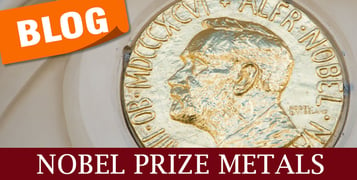 “While the invading forces marched in the streets of Copenhagen, I was busy dissolving Laue’s and also James Franck’s [Nobel Prize] medals.”1
“While the invading forces marched in the streets of Copenhagen, I was busy dissolving Laue’s and also James Franck’s [Nobel Prize] medals.”1
Let us travel back to the 1940s. The Second World War is sweeping across Europe. As Denmark is being occupied by German forces, George de Hevesy doesn’t need to use weapons to protect his colleagues. He relies on science!
Niels Bohr’s Institute of Theoretical Physics in Copenhagen was a safe place for persecuted physicists since the start of the war. German Nobel Prize winners in physics, Max von Laue (1914) and James Franck (1925), had sent their precious Nobel Prize medals to Niels Bohr for safe keeping.
Under Hitler’s rule, sending gold out of Germany was “almost a capital offense.”1. As each medal had the name of its recipient engraved upon it, there was a real risk for Laue and Franck if the medals were discovered by the German troops. This was Bohr’s concern when Denmark was invaded.
George de Hevesy recalls in his book Adventures in Radioisotope Research the morning he and Bohr were wrestling with how to conceal the medals. Hide them? The laboratory would eventually be ransacked by the invaders. Bury them? If they were unearthed, von Laue and Franck would suffer the consequences. Dissolve them…?
Three years later, Bohr’s institute was occupied and searched very carefully, but no trace of the medals was found. They had safely waited out the war dissolved in a flask filled with a fiery orange solution of aqua regia.
Gold is “exceedingly unreactive and difficult to dissolve.”1 It is resistant to oxidation and most acids, except for a special solution called aqua regia2. Named by early alchemists for its ability to dissolve noble metals like gold and platinum with ease, aqua regia is a mixture of nitric acid and hydrochloric acid in the ratio of 1:3.3 Initially this mixture is clear, but it quickly turns yellow, then bright orange, and begins fuming. The color change and fuming nature is due to the formation of nitrosyl chloride (NOCl) and elemental chlorine gas (Cl2).4
HNO3 + 3 HCl → NOCl + Cl2 + 2 H2O
The nitrosyl chloride breaks down further into nitric oxide (NO) and chlorine gas (Cl2).
2 NOCl → 2 NO + Cl2
The nitric oxide can react with atmospheric oxygen (O2) to form nitrogen dioxide (NO2), a red gas.
2 NO + O2 → 2 NO2
After the war had ended, the gold was precipitated and recovered from the solution of aqua regia. The Nobel Foundation generously presented von Laue and Franck with new Nobel Prize medals,1 minted from their original gold. George de Hevesy used chemistry to do the right thing, and that makes him noble in more ways than one. You don’t have to have a Nobel Prize to change the world. By doing the right thing when given the opportunity, we can all make a difference!
References:
1. De Hevesy, George. Adventures in Isotope Research. Pergamon Press, 1962. Accessed 9 Feb 2023. https://archive.org/details/adventuresinradi01heve/page/27/mode/1up?view=theater&q=medals
2. Britannica, The Editors of Encyclopaedia. "noble metal". Encyclopedia Britannica, 6 May. 2021, https://www.britannica.com/science/noble-metal. Accessed 9 February 2023.
3. Britannica, The Editors of Encyclopaedia. "aqua regia". Encyclopedia Britannica, 17 Jan. 2023, https://www.britannica.com/science/aqua-regia. Accessed 9 February, 2023.
4. National Center for Biotechnology Information. "PubChem Compound Summary for CID 90477010, Aqua regia" PubChem, https://pubchem.ncbi.nlm.nih.gov/compound/Aqua-regia. Accessed 9 February, 2023.
